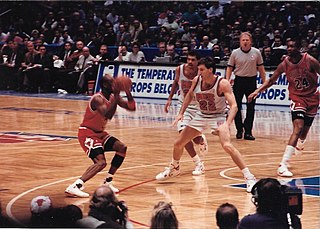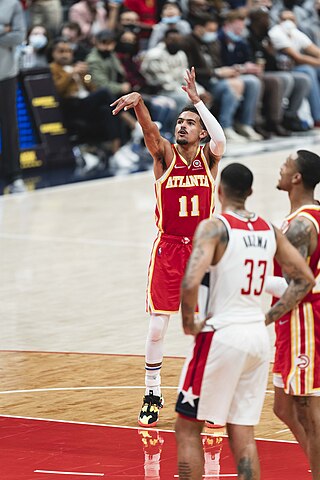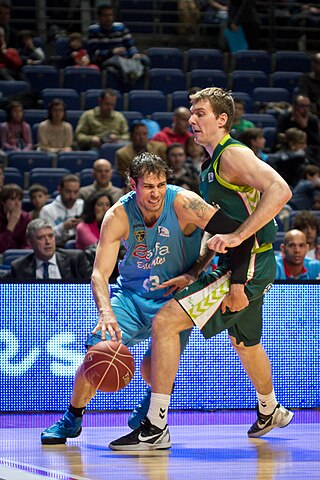Related Research Articles

Basketball is a team sport in which two teams, most commonly of five players each, opposing one another on a rectangular court, compete with the primary objective of shooting a basketball through the defender's hoop, while preventing the opposing team from shooting through their own hoop. A field goal is worth two points, unless made from behind the three-point line, when it is worth three. After a foul, timed play stops and the player fouled or designated to shoot a technical foul is given one, two or three one-point free throws. The team with the most points at the end of the game wins, but if regulation play expires with the score tied, an additional period of play (overtime) is mandated.

In basketball, the basketball court is the playing surface, consisting of a rectangular floor, with baskets at each end. Indoor basketball courts are almost always made of polished wood, usually maple, with 3.048 meters (10 ft)-high rims on each basket. Outdoor surfaces are generally made from standard paving materials such as concrete or asphalt. International competitions may use glass basketball courts.
In basketball, a technical foul is any infraction of the rules penalized as a foul which does not involve physical contact during the course of play between opposing players on the court, or is a foul by a non-player. The most common technical foul is for unsportsmanlike conduct. Technical fouls can be assessed against players, bench personnel, the entire team, or even the crowd. These fouls, and their penalties, are more serious than a personal foul, but not necessarily as serious as a flagrant foul.

A shot clock is a countdown timer used in a variety of games and sports, proving a set amount of time that a team may possess the object of play before attempting to score a goal. Shot clocks are used in several sports including basketball, water polo, lacrosse, poker, ringette, korfball, tennis, ten-pin bowling, and various cue sports. It is analogous with the play clock used in American and Canadian football, and the pitch clock used in baseball. This article deals chiefly with the shot clock used in basketball.

In basketball, free throws or foul shots are unopposed attempts to score points by shooting from behind the free-throw line, a line situated at the end of the restricted area. Free throws are generally awarded after a foul on the shooter by the opposing team, analogous to penalty shots in other team sports. Free throws are also awarded in other situations, including technical fouls, and when the fouling team has entered the bonus/penalty situation. Also, depending on the situation, a player may be awarded between one and three free throws. Each successful free throw is worth one point.

In basketball, a personal foul is a breach of the rules that concerns illegal personal contact with an opponent. It is the most common type of foul in basketball. A player fouls out on reaching a limit on personal fouls for the game and is disqualified from participation in the remainder of the game.

Streetball is a variation of basketball, typically played on outdoor courts and featuring significantly less formal structure and enforcement of the game's rules. As such, its format is more conducive to allowing players to publicly showcase their own individual skills. Streetball may also refer to other urban sports played on asphalt. It is particularly popular and important in New York City and Los Angeles, though its popularity has spread across the United States due to the game's adaptability.

The rules of basketball are the rules and regulations that govern the play, officiating, equipment and procedures of basketball. While many of the basic rules are uniform throughout the world, variations do exist. Most leagues or governing bodies in North America, the most important of which are the National Basketball Association and NCAA, formulate their own rules. In addition, the Technical Commission of the International Basketball Federation (FIBA) determines rules for international play; most leagues outside North America use the complete FIBA ruleset.
In basketball, an illegal dribble occurs when a player ends their dribble by catching or causing the ball to come to rest in one or both hands and then dribbles it again with one hand or when a player touches it before the ball hits the ground. The dribble also ends when the dribbler palms/carries the ball by allowing it to come to rest in one or both hands. This is a palming/carrying the ball violation if the player continues with another dribble.
In basketball, traveling is a violation that occurs when a player takes too many steps without dribbling the ball. Traveling is also called, predominantly in a streetball game, "walking" or "steps". If the pivot foot is lifted, a pass or try for made basket must be made before the pivot foot is replaced to the floor.

In basketball, a flagrant foul is a personal foul that involves excessive or violent contact that could injure the fouled player. A flagrant foul may be unintentional or purposeful; the latter type is also called an "intentional foul" in the National Basketball Association (NBA). However, not all intentional fouls are flagrant fouls, as it is an accepted strategy to intentionally commit a foul in order to regain possession of the ball while minimizing how much time elapses on the game clock.

This glossary of basketball terms is a list of definitions of terms used in the game of basketball. Like any other major sport, basketball features its own extensive vocabulary of unique words and phrases used by players, coaches, sports journalists, commentators, and fans.
A defensive three-second violation, also known as illegal defense, is a basketball rules infraction in the National Basketball Association (NBA), which was added prior to the 2001-2002 season. It is assessed when a member of the defending team spends more than three seconds in the free throw lane while not actively guarding an opponent. To be considered actively guarding an opponent, a defender must be within arm's length of an opponent and must be in a guarding position. A violation will not be called if an offensive player is in the act of shooting, if the offensive team loses control of the ball, if it is imminent that the defender's position will become legal, or if the defender is guarding a player who has possession of the ball.

The Gus Macker 3-on-3 Basketball Tournament is a nationwide event for players of a variety of age and skill levels in the United States. Although every tournament is different, a typical Gus Macker event involves basketball courts set up in parking lots or closed-off public streets. Tournaments are mid-level to major sports media events and are held virtually every weekend from spring through summer.
Delay of game is an action in a sports game in which a player or team deliberately stalls the game, usually with the intention of using the delay to its advantage. In some sports, the delay of game is considered an infraction if it is longer than that permitted according to the game's rules, in which case a penalty can be issued. Some sports that have a delay of game penalty are American football, Canadian football, ice hockey and association football.

The key, officially referred to as the free throw lane by the National Basketball Association (NBA), the National Collegiate Athletic Association (NCAA), the National Association of Intercollegiate Athletics (NAIA), and the National Federation of State High School Associations (NFHS), and the restricted area by the International Basketball Federation (FIBA), is a marked area on a basketball court surrounding the basket, where much of the game's action takes place.

In basketball, an official enforces the rules and maintains order in the game. The title of official also applies to the scorers and timekeepers, as well as other personnel that have an active task in maintaining the game. Basketball is regarded as among the most difficult sports to officiate due to the speed of play, complexity of rules, the case-specific interpretations of rules, and the instantaneous decision required.
Basketball is a ball game and team sport in which two teams of five players try to score points by throwing or "shooting" a ball through the top of a basketball hoop while following a set of rules. Since being developed by James Naismith as a non-contact game that almost anyone can play, basketball has undergone many different rule variations, eventually evolving into the NBA-style game known today. Basketball is one of the most popular and widely viewed sports in the world.
In basketball, a common violation is the most minor class of illegal action. Most violations are committed by the team with possession of the ball, when a player mishandles the ball or makes an illegal move. The typical penalty for a violation is loss of the ball to the other team. This is one type of turnover.
The time line, in basketball, is a name for the center line that reflects the rule that the offensive team has a limited amount of time to advance the ball past this line, from the backcourt to the frontcourt, in a scoring drive.
References
- ↑ NBA Official Rules (2009-2010) Archived 2012-01-11 at the Wayback Machine Rule 10, Section III, (2). Retrieved July 30, 2010
- ↑ 2009-2011 Men's & Women's Basketball Rules Archived 2012-08-06 at the Wayback Machine Rule 4, Section 13, Article 1. Retrieved July 30, 2010
- ↑ NCAA news release, June 8, 2015
- ↑ 2009-2011 Men's & Women's Basketball Rules Archived 2012-08-06 at the Wayback Machine Rule 4, Section 42, Article 2. Retrieved July 30, 2010
- ↑ 2009-2011 Men's & Women's Basketball Rules Archived 2012-08-06 at the Wayback Machine Rule 4, Section 42, Article 3 and 4. Retrieved July 30, 2010
- ↑ FIBA Official Basketball Rules (2010) Rule 5, Section 27.1. Retrieved July 30, 2010
- ↑ RULE NO. 10-VIOLATIONS AND PENALTIES
- 1 2 NBA Official Rules (2009-2010) Archived 2012-01-11 at the Wayback Machine Rule 10, Section XV. Retrieved July 30, 2010
- ↑ FIBA Official Basketball Rules (2010) Rule 7, Section 43.2.3 Retrieved July 30, 2010
- ↑ FIBA Official Basketball Rules (2010) Rule 7, Section 43.3.1. Retrieved July 30, 2010
